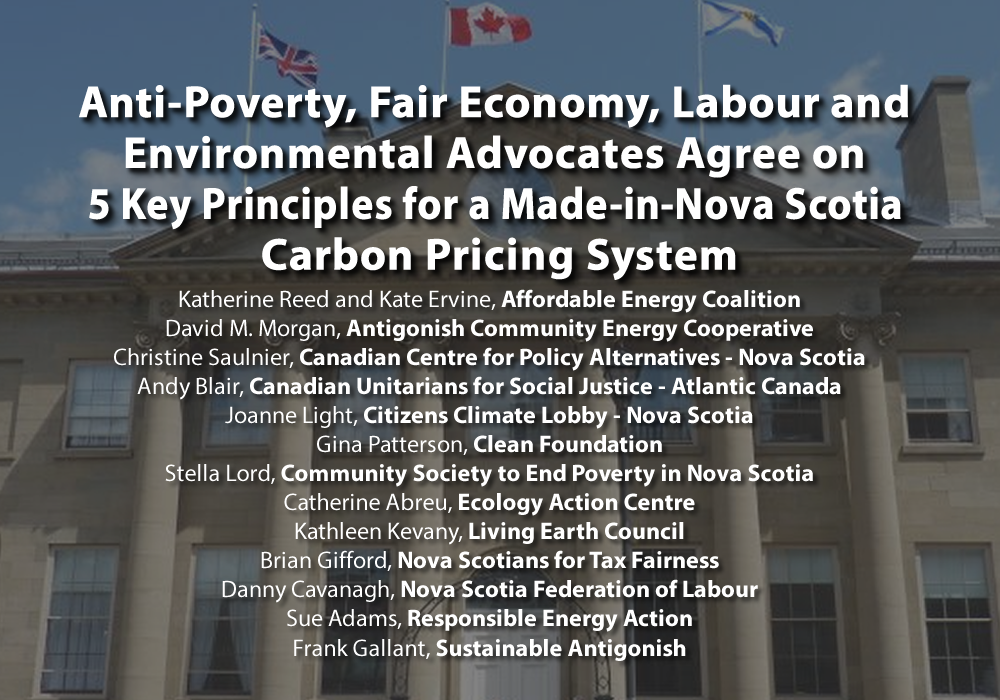
APRIL 18, 2016
Premier McNeil and Finance Minister Delorey,
The dramatic social and economic costs of a changing climate are well-documented, requiring an immediate and multi-pronged strategy on the part of governments to meet the challenges faced today, which will continue to intensify for future generations. Canada’s commitment to the Paris target of limiting average global warming to 1.5 degrees Celsius means we need to increase the ambition of our provincial climate plan.
Nova Scotia’s investments in energy efficiency and renewable energy, combined with the province’s legislated caps on greenhouse gas emissions, have set our electricity sector on the right course.
Work remains in addressing carbon pollution from other sources, like transportation. At the same time, it is clear that energy affordability is a top concern for Nova Scotians especially for those living on low and moderate incomes.
Done right, a made-in-Nova Scotia approach to carbon pricing can help us target the sources of pollution our current laws are missing, while also giving us new financial resources we can use to help vulnerable people and invest in our communities.
Carbon pricing is the new norm in Canada with five provinces, representing almost 90% of the country’s population, committed to a carbon tax or cap and trade system. The federal government is clear about its intentions to work with provinces as they design carbon pricing policies. Clearly some form of carbon pricing is coming to Nova Scotia.
Now is the moment to take advantage of political momentum and relatively low oil prices to design a carbon pricing system tailored to Nova Scotia’s particular circumstances and needs. Failure to do so may result in hasty adoption later, amid increasing pressure from the Federal government and nearby jurisdictions with their own systems. Nova Scotia can choose to lead the way in our region, or we will be forced to follow.
We, the undersigned, urge Nova Scotia government to use carbon pricing as a tool to take us where we need to go as a province.
Nova Scotia needs to begin a conversation about how carbon pricing can work for us. We understand that there are a variety of approaches our province might take to putting a price on carbon pollution.
We offer the following five principles as key elements of any approach we ultimately develop for a Nova Scotia carbon price:
Effective: the price should start at a level in line with other Canadian systems and increase at regular, predictable intervals to a level that is high enough to serve as a disincentive to environmentally harmful activities and an incentive for shifts to cleaner technologies. Keeping in line with other jurisdictions does mean that the price alone will not be high enough to reduce emissions to the level necessary and, therefore, the revenue from the price must be used to support a just and equitable transition to a low carbon economy.
Fair: government must compensate low- to middle-income households so that modest income households can afford higher prices and low income households are more energy secure than they are at present. Therefore, for low income households this compensation must cover more than the extra costs associated with a carbon price and compensation must increase as the price increases. Carbon pricing should also not adversely affect the public sector so that services are not cut or restricted to accommodate higher costs because that will disproportionately affect low income households.
In addition, part of the revenue generated from a carbon price should be used to support Nova Scotia’s low-carbon transition, with a portion allocated to projects and initiatives that support the social and economic development of low-income communities and households, in conjunction with low-carbon initiatives.
Transparent: design and implement a price that is easy to understand by Nova Scotians including the impact on the environment, the economy, and their own household. The government should enshrine these principles in law and legislate requirements about exactly how revenue will be used.
Efficient: as much as possible, make use of existing regulatory infrastructure to administer a carbon pricing system to ensure that the system is low cost to implement and operate.
Economically Sustainable: ensure that the price fosters a low-carbon economic transition, which does not have an adverse impact on workers or the economy (both rural and urban), by coupling the introduction of a carbon price with public investment to generate green job opportunities.
Ultimately, a carbon price is only one essential piece in a suite of policies within a broader climate change prevention and mitigation framework. If implemented using these five principles, carbon pricing, alongside complementary regulations and standards, promises a wealth of co-benefits for Nova Scotians: reduced illness and morbidity; lower provincial healthcare costs; reduced energy poverty; decreased overall household spending as energy efficiency and access to renewables improves; and the growth of green-sector jobs to support a low-carbon transition, allowing more Nova Scotians to stay here.
The Nova Scotia government should immediately create a multi-sectoral working group on this issue, including environmental, anti-poverty and fair economy groups.
Signed,
Katherine Reed and Kate Ervine, Affordable Energy Coalition
David M. Morgan, Antigonish Community Energy Cooperative
Christine Saulnier, Canadian Centre for Policy Alternatives – Nova Scotia
Andy Blair, Canadian Unitarians for Social Justice – Atlantic Canada
Joanne Light, Citizens’ Climate Lobby – Nova Scotia
Gina Patterson, Clean Foundation
Stella Lord, Community Society to End Poverty in Nova Scotia
Catherine Abreu, Ecology Action Centre
Kathleen Kevany, Living Earth Council
Brian Gifford, Nova Scotians for Tax Fairness
Danny Cavanagh, Nova Scotia Federation of Labour
Sue Adams, Responsible Energy Action
Frank Gallant, Sustainable Antigonish











